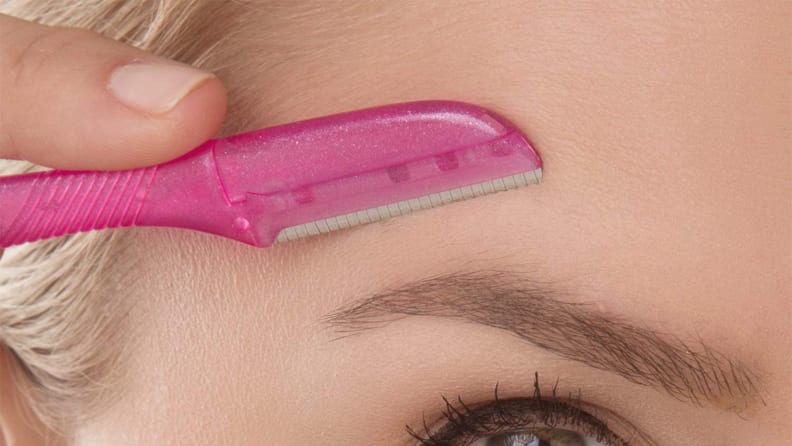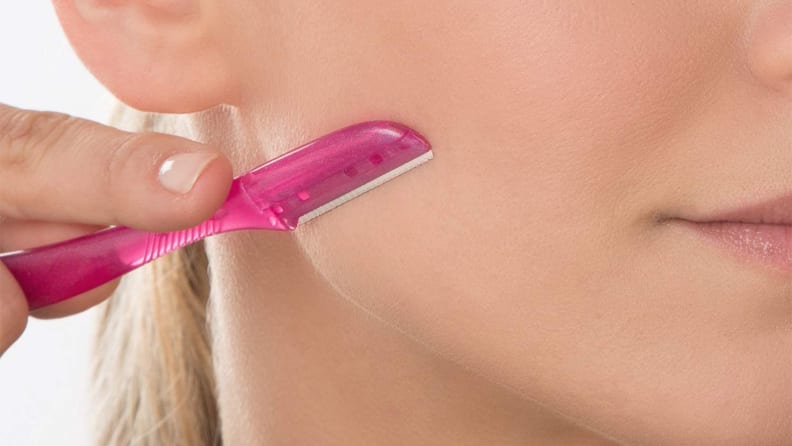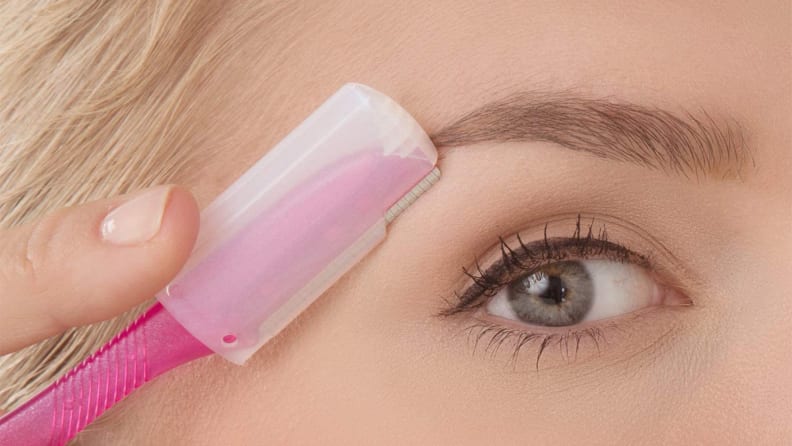What is dermaplaning—and should you get in on the skincare trend?
It may be the answer to smoother skin.
Products are chosen independently by our editors. Purchases made through our links may earn us a commission.
Dermaplaning the face is a popular trend you may have come across already, whether you’ve scrolled past someone shaving their face with the small razor on social media or saw it listed as a treatment at a local spa. In fact, watching someone use a dermaplane tool can be super satisfying, as you’ll see swaths of hair and dead skin cells whisked away as the user glides the tool across the skin.
To learn about how this exfoliating treatment benefits the skin, and if you should try it, we consulted with Dr. Alexis Parcells, a New Jersey-based, board-certified plastic surgeon and owner of Parcells Plastic Surgery.
What is dermaplaning?

To dermaplane, you'll move the tool in downward strokes.
Parcells describes dermaplaning as “a skin procedure that involves using a sharp tool to exfoliate the surface of your skin, the epidermis, as well as [remove] fine hairs.” The tool looks a bit like a medical scalpel with a handle long enough for your hand to grip it and a head that contains a small razor blade with a serrated edge.
You hold the tool similar to how a barber might hold a straight razor to shave a beard, with the tool held horizontally on the face with the razor edge pointing down and the serrated edge angled about 45° on the skin. From there, you’ll sweep the tool in a downward motion pressing very gently against the skin. You’ll see hair accumulate near the blade of the razor and you may feel a slight scratching sensation, but dermaplaning should not be painful or cause any tearing on the skin. You’ll repeat the downward strokes all over the face until you’re satisfied with the amount of skin and hair removal.
Parcells explains what’s happening to the skin during dermaplaning: “A chemical-free form of exfoliation, the blade is scraped over your skin surface to gently remove the dead surface cells and that little layer of peach-fuzz facial hair, leaving the skin ultra-smooth, fresh, and glowing.”
What are the benefits of dermaplaning?

You can dermaplane at home or receive it as a treatment from a professional.
If you’re unhappy with the hair on your face, dermaplaning is one way to get rid of it. “Our faces’ peach fuzz, or vellus hairs, keep us warm and add another layer of protection to the skin," Parcells says. “However, some people’s vellus hairs are thicker and more visible than others and depending on how they feel about that, they might want to have it removed.” Plus, makeup may go on more evenly without those baby hairs for it to cling to.
In addition, the exfoliation that results from dermaplaning can improve your skin’s texture, which can make it appear smoother and brighter. You may experience a glowier, more evened-out complexion for about a week after dermaplaning because you’ve removed excess dead skin and helped quicken the skin cell turnover process.
Parcells says dermaplaning is a great option for someone with sensitive skin who finds chemical exfoliants irritating or scrubs too harsh. It’s also a great alternative solution for someone who can’t use certain ingredients present in chemical exfoliators, such as someone who is pregnant.
What are the drawbacks of dermaplaning?
Dermaplaning can work for those with sensitive skin but it can also cause irritation for anyone with conditions such as rosacea or keratosis pilaris, Parcells says. If you have a skin condition, you may want to opt out of dermaplaning to avoid irritation or contact your dermatologist for their opinion on how it’ll affect your condition.
You may also want to avoid dermaplaning if you have acne or a history of cold sores, as both of these may worsen as a result of this procedure because it may cause irritation or spread bacteria.
As long as you don’t experience any major breakouts or irritation after, Parcells says dermaplaning is a low-risk way to exfoliate the skin and remove facial hair.
How do you prepare the skin for dermaplaning?
Dermaplaning can be done at a plastic surgery or dermatologist's office, at a spa, or at home. Out of precaution, Parcells recommends receiving the treatment from a professional, which will take about 15 minutes and cost anywhere from $40 to $150 per session. If you want to purchase a set of tools, the Schick Hydro Silk Touch-Up pack of three has over 95,000 reviews and a 4.6-star rating and includes blade guards and an attachment for precise areas, like around the eyebrows.
You’ll want to avoid physical or chemical exfoliants a few days before and after the procedure—this includes scrubs or products that contain beta hydroxy or alpha hydroxy acids, like salicylic acid. Check your products several days before an appointment or before you plan to dermaplane at home to ensure you’re avoiding exfoliants. Parcells advises that you’ll want to be diligent about using SPF within the days before and after the treatment to protect against sunburn while your skin is more sensitive.
How should you treat the skin after dermaplaning?
Post-dermaplane session, you may experience some redness. Allow the skin to “breathe” without makeup, exfoliants, or any new or potentially irritating products for a few days after dermaplaning. Stick with a gentle cleanser and moisturizer and, if you want, add extra hydration to your skin with hyaluronic acid, which draws water into the skin. If your skin already leans dry or dehydrated, or you want the extra boost, try the Cosmedica Hyaluronic Acid Serum to replenish the skin’s hydration.
How often can you dermaplane the skin?

Dermaplaning removes dead skin cells and peach fuzz from the face.
You don’t want to over-exfoliate the skin, as it’s important to retain a healthy skin barrier, the outermost layer of the skin that acts as a protective shield against harmful bacteria, fungus, viruses, and other microorganisms. To avoid exfoliating too much, Parcells recommends waiting at least a month between dermaplaning sessions.


